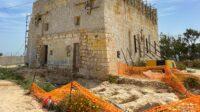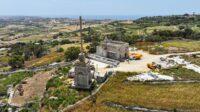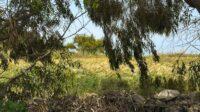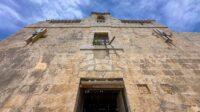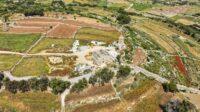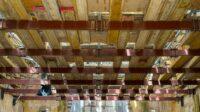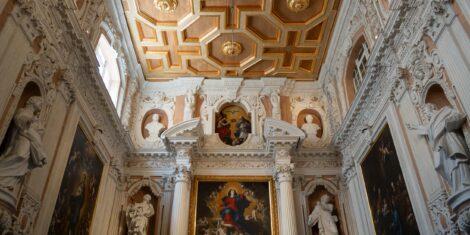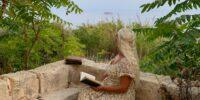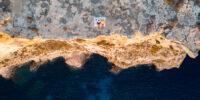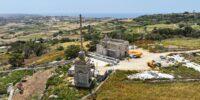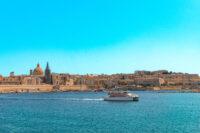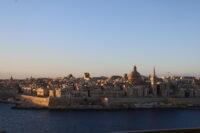As you venture into the beautiful countryside of the village of Siġġiewi you will come across several interesting landmarks. One of the most iconic is known as the Is-Salib tal-Għolja, or Laferla Cross. However, right next to it lies what one would say is a lesser-known, yet equally remarkable site: the Lunzjata Chapel. This little chapel has a history that is as layered and also dramatic as the rock it’s built on. Despite it being small, this humble church tells a story of strong faith, geological issues, and one of truly complex restoration projects for Malta.
Through this article, we will explore the history of this chapel, hopefully encouraging you to add this wonderful site to your itinerary.

A Chapel with Deep Roots but Built on Shaky Ground
The Lunzjata Chapel’s origins date back to the 15th century. In fact, this is the period in which the earliest records that mention this chapel were found. The records indicate that it was built by Don Guljelmu Tonna, Dean of the Cathedral Chapter. In medieval documents this chapel was referred to as Sanctae Mariae de la gkemuna, meaning Saint Mary of Kemmuna. Since then, the chapel has stood as a beacon of Marian devotion on the hill now known as Tal-Għolja.
However, its elevated position came at quite a price. This is because it was built on unstable, clay-rich ground close to the Miġra Ilma fault and a perched water table. This made the chapel highly vulnerable to seismic activity and underground movements. In fact it suffered substantial damage during major earthquakes in the 15th, 17th, 19th, and 20th centuries. Nonetheless, the chapel was so loved that everytime it suffered damages, the local community contributed to its repair.

Nonetheless at One Point it Went From a Sacred Space to a Crumbling Ruin
By the 1960s, the Lunzjata Chapel was no longer serving its pastoral function. Because of this, it was neglected for several years and the geological impact and instability led it to suffer serious deterioration. Among the damages it suffered a partially collapsed roof, dangerously leaning façade, deep wall cracks, subsiding parvis, and to top it all off, a severe pigeon infestation.
In 2019, the Restoration and Preservation Department, alongside the Archdiocese of Malta kickstarted a restoration project aimed at breathing new life in this iconic chapel.

Several Years of Challenges and Restoration
After two years of studies followed by delays caused by the COVID-19 pandemic, restoration began in early October 2023. The focus of this project was that of literally stabilising the chapel from the ground up.
Engineers devised a system of interlinked and reinforced concrete beams beneath the perimeter walls. These beams are tied to seven deep foundation piles drilled 30 metres below ground, and eight steel anchors inclined to connect to the plateau’s stable inner core. The aim behind all of this is to bypass the crumbling surface soil and in turn keep the chapel firmly rooted.
Beneath the chapel, workers also stabilised a cave carved into the coralline limestone by casting a concrete slab over it. This was later buried under soil for structural safety.
The Restoration Came Across Several Archeological Surprises
As with any thorough restoration project, the process unveiled some hidden secrets. In fact, a number of archaeological remains were discovered and preserved. Even the chapel’s walls turned out to be more complex than expected. This is because they were built with four ashlar skins instead of two. The solution to restoring these was making use of a delicate and innovative technique which led to “stitch” all the layers together, reinforcing the structure without dismantling its history.
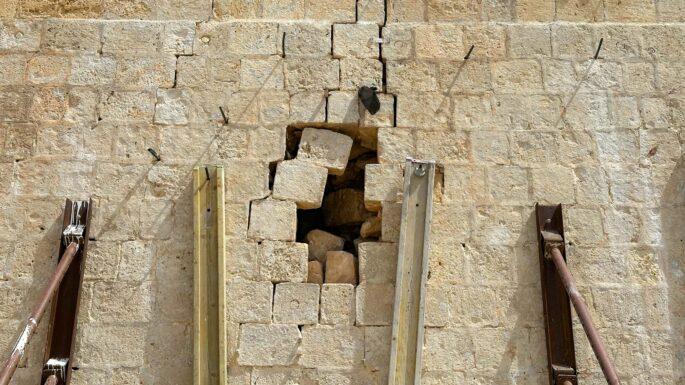
A Collaborative Experience
The project’s restoration works are being led by architect Ivana Farrugia and supported by a multidisciplinary team from the Restoration and Preservation Department and geotechnical expert Dr. Adrian Mifsud. In the meantime, the construction works are being carried out by Ta’ Rdum Construction Ltd., following a public procurement process.
Future stages of this refurbishment include rebuilding the roof, consolidating the exterior, and cleaning and restoring the interior. All of this will eventually return the chapel to its former dignity.
A Literal Stone’s Throw Away from the Laferla Cross
The chapel shares its dramatic hilltop with the famous Laferla Cross, known in Maltese as the ‘Is-Salib tal-Għolja’. This is a beloved Maltese pilgrimage site, particularly visited during the Holy Week. Originally constructed in 1903 under the supervision of Ġanni Mercieca and named after Fr. Paul Laferla, the Cross commemorates the Holy Year and stands as a spiritual landmark.
The Cross itself has been repeatedly restored, most notably in 1984 after it was threatened by erosion. Nowadays it remains a hub for religious tradition. Every Maundy Thursday and Good Friday since 1994, the path leading to the Cross is lit with torches and candles, creating a luminous trail of devotion up the steep hill, which some pilgrims climb barefoot in silence.
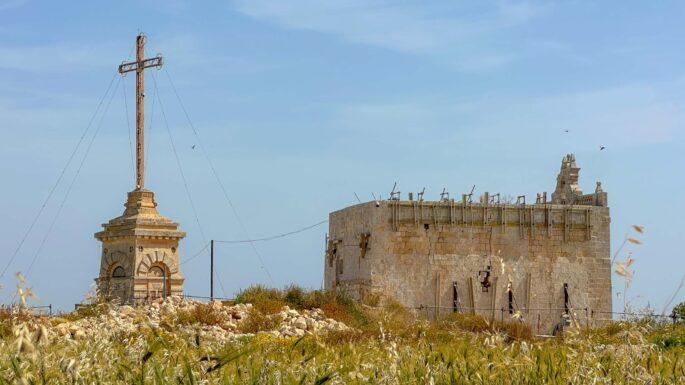
Why You Should Visit
A visit to the Lunzjata Chapel and the Laferla Cross offers more than a glance at Malta’s architectural past. It’s a front-row seat to a living restoration, set against the dramatic backdrop of Siġġiewi’s nature. Furthermore, it is a spiritual location that was shaped by centuries of Catholic tradition in Malta.
So whether you’re a heritage enthusiast or a lover of sacred sites, or you are simply in search of a quiet moment in one of Malta’s most beautiful naturalistic villages, the Lunzjata Chapel offers a truly powerful journey.

